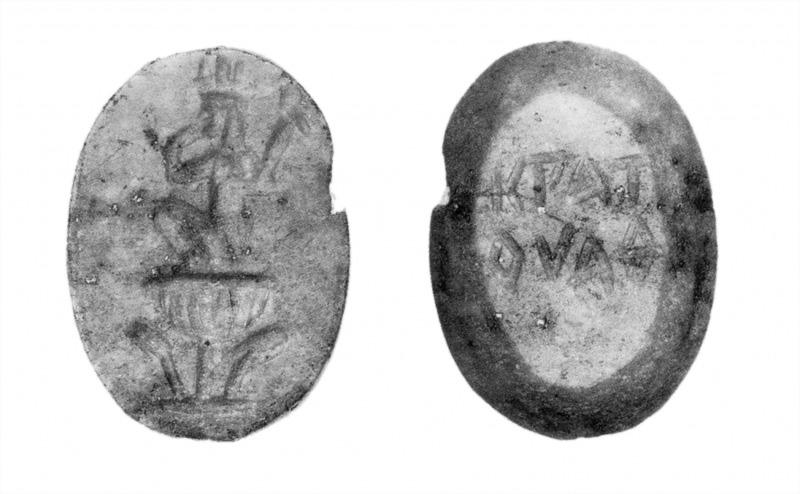Bonner, SMA, 198.
to the Babylonian god Nebo.55 Others have taken it to be of Egyptian origin and recognized “lady of Uto” in the first half of the word.
Ζαγουρη is placed round the head of Harpocrates, each letter at the end of a ray, on an interesting gem of the Newell collection,56 and also after Iao Sabaoth Arbathiao on the planetary stone. These examples are of importance because they contradict Hopfner's statement that Zagoure is a name of Seth.57 The word is more than once used in the papyri in association with solar names.58
Ιω occurs in invocations of Set-Typhon, as in Ιω Σητ round the figure of an ass-headed god,59 and in the formula Ιω ερβηθ ιω πακερβηθ ιω βολχοσηθ. If it is not a mere exclamation, it may represent the Coptic eio, “ass,” the Typhonic animal. The possibility that it was sometimes confused with Ιαω is not to be excluded.60 In the Demotic Magical Papyrus the formula Io erbeth, etc., begins an invocation of Set which, as the operator boasts, the god cannot refuse to hear.61 Though it is common in curse tablets, I have not seen it on gem amulets except in one instance, a stone in the British Museum representing an uncouth demon with three animal heads.62 In spite of the Typhonic character of the words, Io erbeth occurs in an invocation of Apollo-Horus — another instance of the inconsistent use of many long magical sequences.63
Κανθεσουλε seems to occur only on certain amulets intended to cure diseases of the eye, which bear the device of a lizard. Illustrations have been published by Panofka and by Delatte.64 I have not seen the word κανθεσουλε in the papyri, but in default of an index it could easily be overlooked.
Κρατουαθ (variants show initial χ, final τ) is almost certainly a name of Harpocrates. It is cut on the reverse of designs showing the young god riding a goose, or seated on a lotus flower or in a boat, or holding up the mummy of Osiris.65 The word may represent  rd wa῾ty, “the unique child.” However,
rd wa῾ty, “the unique child.” However,
55 In DMP 23, 16, the words Neboutosoualeth Aktiophi Ereschigal immediately follow the Io erbeth sequence, which the operator introduces with the words (addressed to Typhon Seth): “I invoke thee by thy powerful name in words which thou canst not refuse to hear.” But the N. A. E. logos is not therefore to be taken as a name of Seth; it is only used as a formula of power, like the palindrome which immediately follows it.
57 Archiv Orientalni, 3, 343.
58 PGM XIII, 146; IV, 1555; V, 479. It also appears as a name of God in the prayer of Jesus in the Pistis Sophia (Chap. 136, p. 232, Schmidt). In P. Oslo I the name is placed over a cock-headed demon with human legs ending in snake heads instead of feet; it is not Set, as Eitrem thought, but a form of the common anguipede that is represented on amulets (so Procopé-Walter in ARW 30, 41). Zagoure is also written under a stethocephalic demon with Iao above. The identity of this demon is unknown; the names may be used as mere words of magical power, not as belonging to the figure. See P. Oslo I, pp. 5–6, 38, and Pls. 1 and 2.
59 Petrie, Amulets, 135 g.
60 See Ganschinietz in PW IX, 702, 716.
61 DMP 2,3, 14 f.; PGM XIV, 21 f.
63 PGM II, 114.
65 B. M. 56209, 56309, 56349, 56527, 56530; De Ridder 3449; D. 214; Montfaucon, II, 2, Pl. 125, 5 (from Spon).
Last modified: 2012-11-01 20:33:18
Link: cbd.mfab.hu/pandecta/1643








